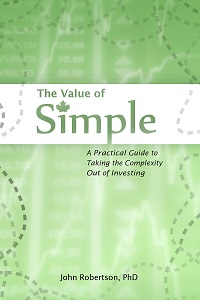Ben asked how I go about picking stocks. I’d like to start by repeating that picking stocks is a bit of a fool’s game. Most people (and professional mutual funds) who try to beat the market simply don’t. Investing in the market via a low-cost index fund is often the best, easiest thing to do. Sometimes, you won’t beat the market because you weren’t diversified enough, took on too much risk (if you have a big loss, such a certain holding going bankrupt overnight due to management fraud). Sometimes, it’s because you’re too diversified and an otherwise ho-hum market was driven to success by the astronomical performance of a few names in the index (Nortel, or more recently, RIM and POT). I mentioned two stocks that I liked back in that post. One, Priszm (QSR.UN) is up about 10%, but still not quite as much as I had anticipated. Teranet (TF.UN) is actually down about 3%.
So to start off with, I don’t have a stock picking “process” or algorithm. I should, and I know I should, but I don’t. That said, there are a number of things that I think about and look at with a stock before deciding to invest in it. The first step in a putative algorithm would be how I come across a particular company in the first place, and that’s largely luck and happenstance. Sometimes, I may decide to look into a particular sector, and if there’s an ETF for that sector (such as energy) then I may see what the top holdings in that are, in case for some reason I don’t want to get the ETF as a whole, or just start internet searching. But often it’s just serendipity: either my dad will say something about a company, or I’ll notice it in the news, or I’ll be shopping somewhere and say “damn, this store/product stands to make a mint, who owns it?”
In fact, I have a lot of interaction with my dad, and so far have bounced almost all of my investment ideas off him. (Technically, I’ve bounced all of them off him, but some such as investing in banks, he’s dismissed out of hand, so I haven’t gotten useful information for all of them). That works well since it can be tempting to succumb to confirmation bias and fall in love with a company that you yourself discovered; a second pair of eyes looking for the downside can be quite helpful. If it’s a company he’s familiar with, I can ask him about what he thinks of the management, and he may have useful information on that count, which is something I have no idea how to research.
I’ll look at broker reports, and read the summary of the company’s financials, looking for things like stable/reliably growing earnings (esp. earnings that may be goosed by one time issues), free cash flow, manageable debt, etc. For large companies, I’ll look at how they’re valued (P/E ratio, price/book, etc.) and how that compares to other companies in that sector and over time. For smaller companies, I try to guess at market saturation, room left to grow, sentiment, word-of-mouth. I read what the analyst has to say, how they got to the numbers and recommendation they did, what they see as the downside. I also look at dividends and payout rates, especially for income trusts. There’s a certain value to getting dividends, in being “paid to wait”, or to simply get an income stream like with an income trust. There’s a lot of value to getting cash money right now, both psychological and financial. Due to the way taxes work, if I buy a great stock that goes up 10% per year and sell after 5 years, I pay all the tax on the capital gains in that 5th year. But since I’m a student with a low tax rate now, and the anticipation of a high tax rate later, there’s value to instead having a stock whose price doesn’t move, but pays out 10% in cash every year (that I pay taxes on as I go), even if the tax rate on distributions isn’t quite as favourable as it is on capital gains… but that’s getting a little esoteric for deciding on which stocks to buy.
Even if I like a stock, it’s important to make sure that the stock is “value-priced”, and I find that quite hard to do. There’s a formula I found, reportedly based on a thought process that Warren Buffet uses that you might find if you search around for “future value of free cash flow” (sorry, no link handy). I find using that gives me a pretty low, conservative stock price that most companies only hit in incredibly terrible markets like this… but it does help me feel better about buying in conditions like this. Sometimes, like if you go back to my post about CIBC, you’ll see I try a couple of different methods to try to figure out how much that one should be worth. Interestingly, I thought I was being too conservative with CIBC and watched it tank, then flatline, figured it had hit bottom, bought some, then watched it tank some more into the range of what I had initially figured, and wouldn’t be surprised if it continued to drift down into the centre of that range :) None of this is a particularly specific or systematic discussion though.
Instead, perhaps a few case studies would help. Here are a few stocks that I’m looking at now or did recently, and some of the things I focused on in the buying process.
Right now, pretty much any bank you care to pick has had its share price hammered by this subprime credit crisis. I think some of them might be better bets than others, but they’re all looking attractive to me, especially today after another haircut across the sector. I like the Canadian banks slightly better than the American ones: I think something like Citi might have more opportunity to bounce back and give some stellar returns, but I also see it as being riskier. Even CIBC, what might be the hardest-hit Canadian bank isn’t actually in danger of going out of business, and I don’t think this subprime nonsense will really keep them down for more than a few years (and remember: that’s the kind of timescale I tend to be working on). TD is I think probably the best Canadian bank, and one that I owned for a while until I got scared off by the instability of the sector (but came so close to buying again when it touched $63.50 earlier today). So for a stock like this, current events are a big driver in the share price, so before investing I spent hours out there reading news articles and blogs about the subprime crisis. What was it, what caused it, how many more years can we expect it to drag out, how bad is it going to be for the banks, does TD have any exposure to this ABCP? All questions I tried to at least wrap my head around the issues, even if there was no definitive answer. Unless they’re outright lying to us, TD has managed to avoid investing in the ABCP nonsense, and so shouldn’t have direct losses for that — and that meshes well with anecdotal evidence my dad shared about TD management and their Enron experience (basically, that management has a bit of a “never again” philosophy about it, and does not accept “but every other bank is doing it and making money” as a reason to break their risk models and let the brokers buy like lunatics). However, that’s not to say that it can’t hurt their mortgage business. A house might have an owner with a perfect credit rating and TD might give them a perfectly safe, conventional mortgage… but some portion of those owners might have gone out to get a second subprime mortgage on the house, and that might come around to hurt TD. That fear, that potential risk, means that we should get their shares at a bit of a discount — and to me it looks like there’s plenty of discount on TD. It’s a good bank, I think it has some decent growth prospects left thanks to its extended hours, and everything else looks to be falling in line. Based on valuing it by Price/Earnings ratio (P/E) at around 12X — a decent floor value for a Canadian bank, it should be around $65, and for the last while it was there or just above. When the market returns to “normality” and the uncertainty around banks finally gets resolved, a 14X P/E would probably be more appropriate, making the share price something more like $75. At $65, it pays out a dividend of approximately 3.5%, which is pretty sweet for a relatively safe payout (I doubt TD will have to cut its dividend, though other banks may be in danger of doing so). Today, TD drifted below $64, but closed just above that, and I’m thinking seriously about getting back into it at this point. The only reason I haven’t yet is that my “dry powder” or cash reserves serving as both my fixed income diversification and patiently-waiting-for-a-super-awesome-buy fund is now down to just enough for a single stock, and while I like TD at these prices, I’m not quite sure it’s “my last one buy” value yet.
Another company I’m liking at the moment is the Yellow Pages Income Trust (YLO.UN). Income trusts are a bit of a weird structure that I admit I don’t fully understand. I know that rather than pay corporate taxes on money they make, they send a large part of it out to shareholders, and the money is taxed as income in their hands instead. They tend to trade based on their distributions and cash flow, and share price rarely moves much in either direction. So, YLO does the Yellow Pages in Canada. I’m sure you’ve heard of it. They make money by people buying advertising in there, and then they send the money out to shareholders in monthly distributions. There are some concerns about YLO, particularly about how an economic downturn might hurt ad revenues, and how readership may falter in the age of the internet. However, I know that I am one of the most internet-addicted people on the planet, but when I want a pizza or a plumber, I look in the yellow pages (or their website www.yellowpages.ca) to get local information. There was another rival phone guide sent around a few years ago, and I never used it: it was junk. So their business model appears to be pretty safe in my eyes. Historically, they’ve traded at around $13-14/unit, which represented a yield of about 6% or so. That kind of low yield is usually associated with a very safe income trust that has a strong history of maintaining or increasing its payout and that doesn’t look to be going anywhere. For some reason in the recent market turbulence, YLO dropped down to the $12 range, which represented a yield of something like 9%, and I bought some around there. I looked at the financials, and they make plenty of cash to keep up the distribution; their payout ratio (how much money they pay to shareholders as a fraction of total income) is a healthy 83% or so. That’s a pretty typical, healthy number: when it starts getting above 90%, then you have to worry that an economic bump in the road might lead to a distribution cut. Above 100% and the company is in a seriously nonsustainable position. Anyhow, YLO is generally regarded as a good safe income trust, and as such the price has tended to be stable and the yield has tended to be relatively low. Then after dropping into the $12’s for a month or so, there was another big hit to the share price in the last few days to under $11, where I bought another bunch of it. There’s been no news, no analyst reports that I know of that are bringing the price down, so I see no reason not to recommend it. There is, of course, always that sinking feeling that the “market knows something I don’t”, but for the life of me I can’t see any reason for such a quality company to be priced so low. With this one, I don’t expect the share price to ever get over $12-$13 — that seems like a good place for it to sit for me, but even just collecting 10% a year is a decent return to look forward to. Again, things I looked at when deciding to buy it were analyst reports, discussions with my dad (he also likes it and thinks it’s a quality company, and the only reason he doesn’t own any is that he thought it was overvalued and the yield was too low — at $11 he loves it), and blog posts (themoneygardener in particular is bullish on YLO). It’s rated as an “Action List Buy” by the analysts at TD, and appears to have a good long-term plan for dealing with the end of the income trust age.
CV Technologies (TSE:CVQ) is the maker of Cold FX and some other more recent branch-outs from that line. Earlier this year, everyone seemed to be talking about Cold FX. All the stores were stocking it. Costco was pushing it. Word of mouth was pretty much entirely positive, and I thought to myself that here was a real winner. A product that’s going to really shine, a company with a good model (it’s not just a treatment, it’s a prevention thing that you just have to always keep buying more of!), great word of mouth that seemed to be reaching critical mass, and a favourable ruling by Health Canada that even allows them to claim some scientific backing for certain claims about reducing the severity of colds… I was really enthused about this and ready to invest in CVQ. I didn’t, and so far have been fairly glad of that. First off, despite Cold FX seeming to be everywhere, and not needing as much promotion from Don Cherry these days, the company isn’t really making that much profit off what they’re selling in Canada. What profit they were making in Canada, they took and loaded into a big cannon, and fired it off into the air in a generally southward direction. At least, I think that’s what happened. After showing signs of being successful in Canada, the company went to try to expand into the States, and somehow lost a ton of money trying. I have no idea how that’s possible. Granted, I’m just a grad student, but I would figure that if you’re selling something like a bottle of fancy ginseng pills, you might have advertising and marketing expenses as you try to build awareness in a new country. You might have to put out a few loss-leaders and promotions to get the stores to stock your stuff in the first place, but that should be about it. Generally, you should be making money on each crate you sell to the drugstores, even if those drugstores can’t move the crates of your crap off onto their customers to then order another crate. It’s not like you have to build a network of your own stores and crap… so the fact that these guys just seemed to hemmorage money while trying to expand into what is both a larger market and one that is not really all that far away from a logistics standpoint really raised a red flag for me. Another red flag was that they were going to “restate” some earnings or accounting reports or something at some point along the way. Accounting restatements scare the everloving shit out of me, doubly so when it happens in a small poorly-known company. I’ve been burned with my pants down at least twice now by companies with crooked management who cooked the books or lied or what have you, so when it looks like some of that same crap is going down in this company, I just stayed the heck away. CVQ was trading at just about 70 cents/share when I first got it into my head that ColdFX might be an awesome investment, and since then it’s been bouncing around 60-65 cents, so I look to have done the right thing by shying away.
So I know that’s not hugely helpful in the mess that it’s in now, but it’s a start and I hope that’s enough to foster some discussion and help you out.
Insert standard declaimer about not following financial advice from random people on the internet.



 Questrade: ETFs are free to trade, and if you sign up with my link you'll get $50 cash back (must fund your account with at least $250 within 90 days).
Questrade: ETFs are free to trade, and if you sign up with my link you'll get $50 cash back (must fund your account with at least $250 within 90 days).  Passiv is a tool that can connect to your Questrade account and make it easier to track and rebalance your portfolio, including sending you an email reminder when new cash arrives and is ready to be invested.
Passiv is a tool that can connect to your Questrade account and make it easier to track and rebalance your portfolio, including sending you an email reminder when new cash arrives and is ready to be invested.